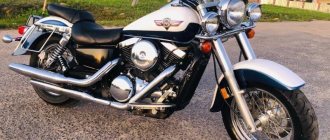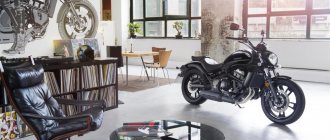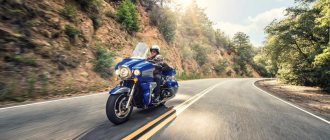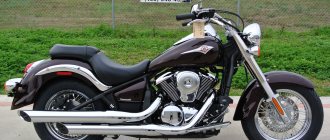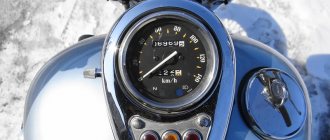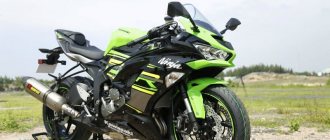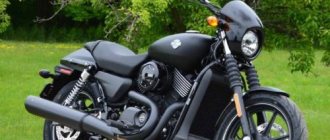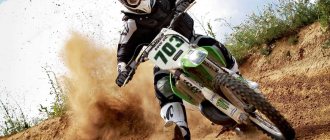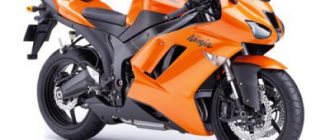| Kawasaki VN 750 Vulcan (1984-2006) |
Cruiser model Kawasaki VN 750 Vulcan
was introduced at the end of 1984 and was sold until 2006.
This model is the first Kawasaki production cruiser with a V-shaped 2-cylinder engine. Despite the fact that the vast majority of Japanese motorcycles have 750 cc engines. see were a purely domestic Japanese product, the Kawasaki VN 750 Vulcan was actively exported to the USA and had a good level of sales there. In 1985, the United States introduced increased customs duties on the import of motorcycles with an engine capacity of over 700 cc. see, which forced Kawasaki to reduce the volume of the Vulcan to 699 cc. see and change its name to Kawasaki Vulcan 700
.
However, a year later, in 1986, customs restrictions were lifted and the original version with an engine capacity of 750 cc was supplied to the US market. see Naturally, such changes were also reflected in the name of the model, which was now called Kawasaki Vulcan 750
.
The model may also be called Kawasaki VN 750 Twin
.
The main feature of the Kawasaki VN 750 Vulcan is its V-shaped 2-cylinder liquid-cooled engine, which produces 66 hp. power and 65 Nm of torque, which makes it perhaps the most powerful motorcycle in the Cruiser class for its engine size. In addition, data from the dyno test show that the declared engine characteristics are underestimated by 8-10% of the actual power and torque values. This fact indicates that either Kawasaki did not have sufficient experience in building classic cruisers, and therefore, out of habit, created a motorcycle with sports characteristics (“the red zone” of the engine begins at 8500 rpm), or this step was deliberate, and the appearance of such of a powerful bike was due only to the desire to outperform competitors, but then it seems illogical to underestimate the actual characteristics of the engine.
Main modifications of the Kawasaki VN 750 Vulcan:
- Kawasaki VZ 750
is the Japanese name for the motorcycle. - Kawasaki VN 750 (Vulcan 750)
is the name of the motorcycle for the US market.
Other features of the Kawasaki VN 750 Vulcan include a steel frame, a cardan drive, double disc brakes at the front and a drum at the rear, hydraulic compensators and simple suspension in the form of a conventional telescopic fork at the front and a double shock absorber at the rear.
The model was produced until 2006, after which it was discontinued. In 1995, the Kawasaki VN 800 Vulcan came to the market as a replacement for the obsolete Kawasaki VN 750 Vulcan, although the latter also continued to be sold in parallel, particularly in the US market.
The main competitors of the Kawasaki VN 750 Vulcan in the class:
- Honda Shadow 750
- Suzuki VS 750 Intruder
- Yamaha XV 750 Virago
Brief history of the model
- 1984 - start of production and sales of Kawasaki VN 750 Vulcan.
Model
: Kawasaki Vulcan 700 (North America).
Factory designation
: VN700-A1.
- 1985 - modification for the American market VN700 gradually leaves the market, completely giving way to the VN750.
Model
: Kawasaki VN750 Twin / Vulcan 750 (North America, Europe, Japan).
Factory designation
: VN750-A1.
- 1986 - no significant changes.
Model
: Kawasaki VN750 Twin / Vulcan 750 (North America, Europe, Japan).
Factory designation
: VN750-A2.
- 1987 - no significant changes.
Model
: Kawasaki VN750 Twin / Vulcan 750 (North America, Europe, Japan).
Factory designation
: VN750-A3.
- 1988 - no significant changes.
Model
: Kawasaki VN750 Twin / Vulcan 750 (North America, Europe, Japan).
Factory designation
: VN750-A4.
- 1989 - no significant changes. Last year of sales in Japan.
Model
: Kawasaki VN750 Twin / Vulcan 750 (North America, Europe, Japan).
Factory designation
: VN750-A5.
- 1990 - no significant changes. The model is temporarily available only in the North American market.
Model
: Kawasaki Vulcan 750 (North America).
Factory designation
: VN750-A6.
- 1991 - no significant changes.
Model
: Kawasaki Vulcan 750 (North America).
Factory designation
: VN750-A7.
- 1992 - no significant changes.
Model
: Kawasaki Vulcan 750 (North America).
Factory designation
: VN750-A8.
- 1993 - no significant changes. The model is again available in Europe.
Model
: Kawasaki VN750 Twin / Vulcan 750 (North America, Europe).
Factory designation
: VN750-A9.
- 1994 - no significant changes.
Model
: Kawasaki VN750 Twin / Vulcan 750 (North America, Europe).
Factory designation
: VN750-A10.
- 1995 - the appearance of the Kawasaki VN 800 Vulcan, which was originally supposed to replace the Kawasaki VN 750 Vulcan. However, both models showed high sales (especially in the USA), so they were produced in parallel. Meanwhile, the VN750 was no longer available in Europe.
Model
: Kawasaki Vulcan 750 (North America).
Factory designation
: VN750-A11.
- 1996 - no significant changes.
Model
: Kawasaki Vulcan 750 (North America).
Factory designation
: VN750-A12.
- 1997 - no significant changes.
Model
: Kawasaki Vulcan 750 (North America).
Factory designation
: VN750-A13.
- 1998 - no significant changes.
Model
: Kawasaki Vulcan 750 (North America).
Factory designation
: VN750-A14.
- 1999 - no significant changes.
Model
: Kawasaki Vulcan 750 (North America).
Factory designation
: VN750-A15.
- 2000 - no significant changes.
Model
: Kawasaki Vulcan 750 (North America).
Factory designation
: VN750-A16.
- 2001 - no significant changes.
Model
: Kawasaki Vulcan 750 (North America).
Factory designation
: VN750-A17.
- 2002 - no significant changes.
Model
: Kawasaki Vulcan 750 (North America).
Factory designation
: VN750-A18.
- 2003 - no significant changes.
Model
: Kawasaki Vulcan 750 (North America).
Factory designation
: VN750-A19.
- 2004 - no significant changes.
Model
: Kawasaki Vulcan 750 (North America).
Factory designation
: VN750-A20.
- 2005 - no significant changes.
Model
: Kawasaki Vulcan 750 (North America).
Factory designation
: VN750-A21.
- 2006 is the final year of production of the Kawasaki VN750 Vulcan and Kawasaki VN800 Vulcan. They are being replaced by the Kawasaki VN900 Vulcan.
Model
: Kawasaki Vulcan 750 (North America).
Factory designation
: VN750-A6F.
Main modifications of the Kawasaki VN 750 Vulcan:
Kawasaki VZ 750 is the Japanese name for the motorcycle.
Kawasaki VN 750 (Vulcan 750) is the name of the motorcycle for the US market.
Other features of the Kawasaki VN 750 Vulcan include a steel frame, a cardan drive, double disc brakes at the front and a drum at the rear, hydraulic compensators and simple suspension in the form of a conventional telescopic fork at the front and a double shock absorber at the rear.
The model was produced until 2006, after which it was discontinued. In 1995, the Kawasaki VN 800 Vulcan came to the market as a replacement for the obsolete Kawasaki VN 750 Vulcan, although the latter also continued to be sold in parallel, particularly in the US market.
Specifications
Technical characteristics of Kawasaki VN 750 Vulcan:
| Model | Kawasaki Vulcan 750 (VN750 Twin) |
| Motorcycle type | cruiser |
| Year of issue | 1984-2006 |
| Frame | steel tubular |
| engine's type | 2-cylinder, 4-stroke, V-shaped |
| Working volume | 749 cm³ |
| Bore/Stroke | 84.9 x 66.2 mm |
| Compression ratio | 10.3:1 |
| Cooling | liquid |
| Number of valves per cylinder | DOHC, 4 valves per cylinder (with hydraulic lash adjusters) |
| Fuel supply system | carburetor, 2x Keihin CVK34 |
| Ignition type | transistor |
| Maximum power | 66.0 hp (48.5 kW) at 7500 rpm - basic version 68.0 hp (50.0 kW) at 7500 rpm - Canadian and South African versions 50.0 hp (36.8 kW) at 7500 rpm - German version |
| Maximum torque | 64.7 Nm (6.6 kgf*m) at 6000 rpm - basic version |
| Clutch | Multi-disc in oil bath, cable drive |
| Transmission | 5-speed |
| type of drive | cardan |
| Front tire size | 100/90-19 57H |
| Rear tire size | 150/90-15 74H |
| Front brakes | 2 discs, 226 mm, 1-piston calipers |
| Rear brakes | drum |
| Front suspension | 38 mm telescopic fork, travel - 150 mm 38 mm telescopic fork (pneumatic), travel - 150 mm - VN700-A1, VN750-A1-A4 |
| Rear suspension | pendulum with two shock absorbers (adjustable preload), stroke - 90 mm |
| Motorcycle length | 2310 mm |
| Motorcycle width | 860 mm |
| Motorcycle height | 1235 mm |
| Wheelbase | 1585 mm |
| Seat height | 750 mm 735 mm - North American version |
| Minimum ground clearance (clearance) | 135 mm 150 mm – Vulcan 750 (North America) |
| Acceleration 0-100 km/h (0-60 mph) | |
| Maximum speed | 180 km/h |
| Gas tank capacity | 13.5 l |
| Motorcycle weight (dry) | 223 kg 219 kg - North American version |
| Motorcycle weight (curb) | 241 kg 236 kg - North American version |
Appearance description
The first Kawasaki Vulcan appeared in 1984. It was a motorcycle made in the American classic style, because it was primarily designed for this consumer market.
Now motorcycles made in this style are designated as the “cruiser” class, i.e. designed for comfortable movement over long distances.
The first Vulcan was equipped with a power plant with a displacement of 700 cubic meters. see, although the full designation of the motorcycle was Kawasaki Vulcan 750.
Subsequently, these bikes were and are being produced with different engines, but the concept of the motorcycle itself remains unchanged .
This is a motorcycle with a low riding position and also a low center of gravity, which makes the not-so-light bike easier to handle.
Massive wide wheels, covered with equally massive fenders, add solidity to the appearance.
The wide driver's seat provides a comfortable seating position.
Adding solidity to the overall picture is the teardrop-shaped tank with a speedometer located on it, a large amount of chrome plating on the motorcycle elements and thick chrome exhaust pipes with signature cuts at the ends.
Reviews
Kawasaki VN750 Vulcan reviews:
Expand Collapse
Well, what can I say, having driven it for 2 seasons, only advantages!!!! My device is from 1985. easy to control, quite traction, cardan, convenient tidy (which, by the way, many classmates cannot boast about). The design is also incomparable, probably because I love absolute symmetry!!!! For me, the fit and design of the remote control is very comfortable!!!! If those are interested in the question, then 750 cubic meters account for 60 hp. 150 km/h goes without straining. On my copy, I reached speeds of up to 200 km/h, and this without a windshield!!!! (who won’t believe it, I have witnesses). In terms of cost, I think ’95 could cost from 100,000 to 180,000 rubles. depending on the condition.
After an accident, restoration and purchase of a new device, it has been collecting dust in the garage for 2 years, and still can’t get around to doing a complete overhaul. As soon as I do everything I will ride it!!!!
I drove this for a whole season. An excellent motorcycle, produced until 1995, I don’t know from what year, mine was 1990. Four-valve cylinder heads, two camshafts each, hydraulic valve compensators, a cardan, two-piston front brakes, quite powerful, two-disc, rear drum. Convenient for the city and long-distance driving, an informative dashboard, there is even a gasoline level indicator, consumption is 5-7 liters per hundred. Very dynamic, the only competitor to the Magna in this cubic capacity, it accelerated to 220 km.h. together.
Of the minuses, it’s the weak point of the electrician, it acts up and oxidizes, I’ve had a lot of trouble with it. I even cleaned the starter button once. When servicing carburetors, you have to disassemble half the motorcycle, and even the carburetors themselves sometimes leak for unknown reasons. The battery for a highly accelerated engine is rather weak, I recommend replacing it with a modern maintenance-free 14Ah from Yasa, it turns more confidently at the start.
The front fork is a bit thin for such a motorcycle; at high speeds it wobbles a little. The Japanese version (VZ) differs from the American version only in the presence of a light switch on the right block.
The impressions are as follows:
1. The wheelbase is too small, if the second number is on board, then the pubis rests against the back. But if the second number is a girl, then it doesn’t bother me.
2. Acceleration and speed are quite pleasant. The 750 is slightly inferior to the one and a half pound, except that the engine speed is twice as high at the same speed as the previous one; the lack of torque is compensated by power, but again it is not annoying.
3. It weighs little, is convenient and adequate to operate.
4. I bought it for 80,000 rubles, but with a small defect - I need to change the needle in the carburetor, the rear cylinder is overflowing, again, little things...
In general, for the money it’s a normal motorcycle. A cardan shaft, a central stand, a fuel level and engine temperature sensor, a tachometer, an emergency stop signal, a remote button for switching the high-low headlights, pneumatic-oil rear shock absorbers with air pumping and four adjustment positions... In short, I’m still mastering the technique.
Approximate price for a motorcycle
This motorcycle, which has become a legend and classic in the world of motorcycles during its production, will not come cheap.
And not all models can now be found with us. Even at official dealers, there are few models of modern production. And if it does, it’s usually the Vulcan 900 Classic model.
But for this motorcycle you will have to pay quite a lot - 475,000 rubles. The Vulcan 1700 version is practically never found in showrooms and can only be bought abroad.
But if you take the secondary market, then this motorcycle is often found there , with different years of production and with different engines.
The cost of these motorcycles starts at 100,000 rubles. and can increase to the level of 600,000 rubles. Approximately the same amount is requested for a Kawasaki Vulcan 1700, but it has already been brought to us and cleared through customs.
Interested in what is the maximum speed of the Honda CB 400? Then you should read our review and you will find out not only this.
Here's another motorcycle worthy of your attention. When you see him in motion and hear him let off the gas, it’s like music.
Video
Not only technical specifications, various descriptions and photos can help a beginner in choosing a motorcycle.
A high-quality video can also be a good help. How else can you evaluate the exhaust from standard mufflers and see the equipment in action? We present to you a test drive of one of the heroes of our article - Kawasaki Vulcan 900. Did you like the article? Tell your friends!
Comments (1)
- Victor:
06/17/2016 at 13:03Any information on tire sizes for the front and rear and possible replacement options?
Answer
